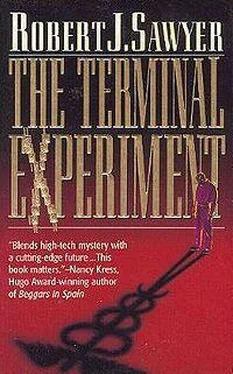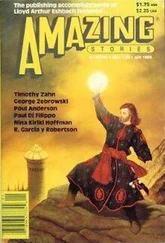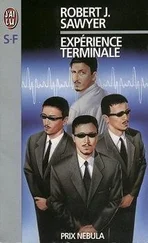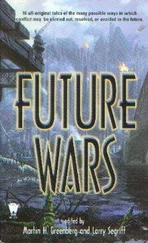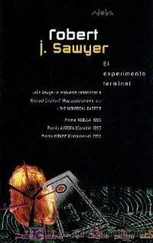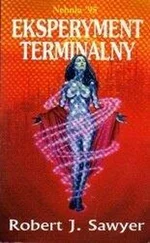Periodically, Peter got bored, and his mind wandered to the night before — the disastrous night out with Cathy’s coworkers. Damn, that had been a mistake.
Fucking Hans.
He couldn’t even shake his head to fling off the thoughts. But by an effort of will, he tried to concentrate on the images. And yet, from time to time, they, too, would provoke the unpleasant memories: A picture of hands that made him think of Hans. Peter and Cathy’s wedding photo. A pub. A parked car.
Nets fired.
They did four two-hour sets of this, with half-hour breaks for Peter to stretch and work his jaw and drink water and go to the bathroom. Sometimes the audio clips would reinforce the visual images — he saw a picture of Mick Jagger and heard “Satisfaction.” And sometimes they were jarringly opposite — the sight of a starving Ethiopian child coupled with the sounds of wind chimes. And sometimes the images shown to his left eye were different than those shown to his right, and sometimes the sound played into one earpiece was completely unrelated to that pumped into the other.
Finally, it was over. Tens of thousands of images had been seen. Gigabytes of data had been recorded. And the sensors in the skullcap had mapped every nook and cranny, every thoroughfare and side street, every neuron and every net in Peter Hobson’s brain.
Sarkar took the disk holding the brain scan down to his computer lab. He loaded it onto an AI workstation and copied everything into three different RAM partitions — producing three identical copies of Peter’s brain, each isolated in its own memory bank.
“What now?” said Peter, sitting backward on a stacking chair and leaning his chin on his arms folded over the chair’s back.
“First, we label them.” Sarkar, sitting on the barstool he preferred to a chair, spoke into the microphone on the console in front of him. “Login,” he said.
“Login name?” said the computer’s voice, female, emotionless.
“Sarkar.”
“Hello, Sarkar. Command?”
“Rename Hobson 1 to Spirit.”
“Please spell destination name.”
Sarkar sighed. The word “Spirit” was doubtless in the computer’s vocabulary, but Sarkar’s accent occasionally gave it trouble. “S-P-I-R-I-T.”
“Done. Command?”
“Rename Hobson 2 to Ambrotos.”
“Done. Command?”
Peter piped up. “Why ‘Ambrotos’?”
“It’s the Greek word for immortal,” said Sarkar. “You see it in words such as ‘ambrosia’ — the foodstuff that confers immortality.”
“That darned private school education,” said Peter.
Sarkar grinned. “Exactly.” He turned back to the mike. “Rename Hobson 3 to Control.”
“Done. Command?”
“Load Spirit.”
“Loaded. Command?”
“Okay,” said Sarkar, turning to face Peter. “Spirit is supposed to simulate life after death. To do that, we begin by paring out all exclusively biological functions. That will not actually involve removing parts of the conscious brain, of course, but rather just disconnecting various networks. To find out which connections we can sever, we’ll use the Dalhousie Stimulus Library. That’s a Canadianized version of a collection of standard images and sound recordings originally created by the University of Melbourne; it’s commonly used in psychological testing. As Spirit is exposed to each image or sound, we record which neurons fire in response.”
Peter nodded.
“The stimuli are all cataloged by the type of emotion they’re supposed to elicit — fear, revulsion, sexual arousal, hunger, et cetera. We look to see which neural nets are activated exclusively by biological concerns, and then zero those out. Of course, we have to go through the images several times in random sequences. That’s because of action potentials: nets might not get activated if a substantially similar combination of neurons was recently triggered by something else. Once we’ve finished doing that, we should have a version of your mind that approximates the way you would be if you were freed of all concerns about meeting physical needs — what you would be like if you were dead, in other words. After that, we’ll do the same thing with Ambrotos, the immortal version, but for it we’ll excise the fear of growing old and concerns about aging and death.”
“What about the experimental control?”
“I’ll feed it the same sorts of images and sound clips, just so that it will have been exposed to the same things as the other two versions, but I won’t zero out any of its nets.”
“Very good.”
“Okay,” said Sarkar. He turned to face the console. “Run Dalhousie Version 4.”
“Executing,” said the computer.
“Estimate time to completion.”
“Eleven hours, nineteen minutes.”
“Advise when complete.” Sarkar turned to Peter. “I’m sure you won’t want to watch the whole thing, but you can see what is being fed to Spirit on that monitor.”
Peter looked at the screen. A monarch butterfly emerging from a cocoon. Banff, Alberta. A pretty woman blowing a kiss at the camera. Some 1980s movie star that Peter sort of recognized. Two men boxing. A house on fire…
NOVEMBER 2011
Sarkar had called Peter early Sunday morning to tell him the training and pruning of the simulacra were complete. Cathy was off looking at garage sales — a hobby whose appeal Peter had never understood — so Peter left a message for her with the household computer. He then hopped into his Mercedes and drove to Mirror Image’s offices in Concord.
Once he and Sarkar were together in the computer lab, Sarkar said, “We’ll try activating the Control simulacrum first.” Peter nodded. Sarkar pushed a few keys then spoke into the microphone stalk rising from the console. “Hello.”
A synthesized voice came from the speaker. “H-hello?”
“Hello,” Sarkar said again. “It’s me, Sarkar.”
“Sarkar!” The voice was full of relief. “What the hell is going on? I can’t see anything.”
Peter felt his jaw drop. The simulation was much more real than he’d expected.
“That’s right, Peter,” said Sarkar into the mike. “Don’t worry.”
“Have I — have I been in an accident?” said the voice from the speaker.
“No,” said Sarkar. “No, you’re fine.”
“Is it a power failure, then? What time is it?”
“About eleven forty.”
“Morning or night?”
“Morning.”
“Why is it so dark, then? And what’s wrong with your voice?”
Sarkar turned to Peter. “You tell him.”
Peter cleared his throat. “Hello,” he said.
“Who’s that? Is that still Sarkar?”
“No, it’s me. Peter Hobson.”
“ I’m Peter Hobson.”
“No, you’re not. I am.”
“What the hell are you talking about?”
“You’re a simulation. A computer simulacrum. Of me.”
There was a long silence, then: “Oh.”
“You believe me?” asked Peter.
“I guess,” said the voice from the speaker. “I mean, I remember discussing this experiment with Sarkar. I remember — I remember everything up to the brain scan.” Silence, then: “Shit, you really did it, didn’t you?”
“Yes,” said Sarkar.
“Who was that?” asked the voice from the speaker.
“Sarkar.”
“I can’t tell the two of you apart,” said the sim. “You sound exactly the same.”
Sarkar nodded. “Good point. I’ll adjust the software to pass on a distinction between my accent and Peter’s. Sorry about that.”
“It’s okay,” said the sim. “Thank you.” And then: “Christ, you did a good job. I feel — I feel just like myself. Except … except I’m not hungry. Or tired. And I don’t itch anywhere.” A beat. “Say, which simulacrum am I?”
Читать дальше
